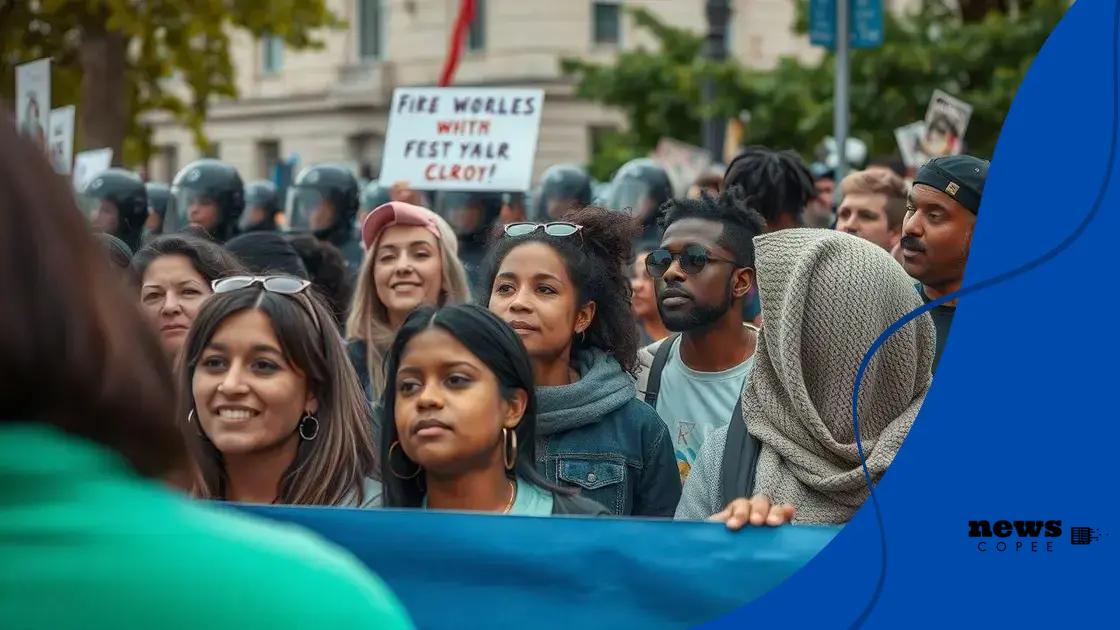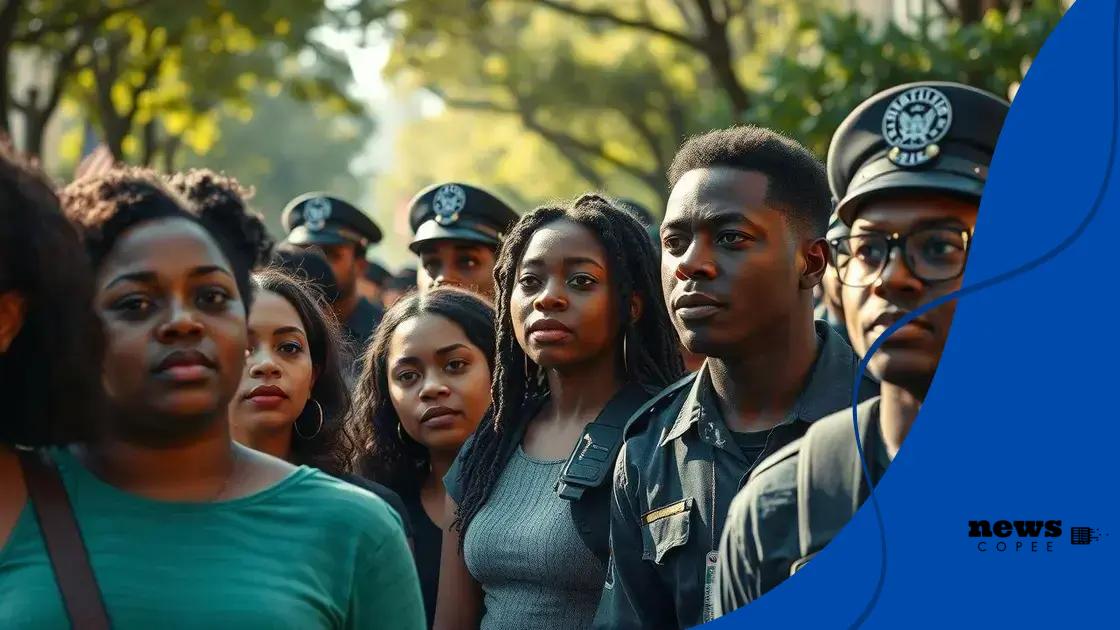Protest policing policies reviewed: the impact on communities

Protest policing policies aim to balance public safety with the protection of civil rights, utilizing technology, community engagement, and de-escalation training to enhance effectiveness and build trust between law enforcement and communities.
Protest policing policies reviewed reveal how law enforcement strategies shape the experiences and rights of citizens. Have you ever wondered about the implications these policies have for our communities and social movements? Let’s dig deeper into this complex issue.
Understanding protest policing policies
Understanding protest policing policies is crucial for citizens and communities. These policies dictate how law enforcement agencies respond to public demonstrations, impacting both the safety of protesters and the overall atmosphere of civic engagement.
The Purpose of Protest Policing Policies
The primary goal of these policies is to maintain order during demonstrations while respecting the rights of individuals to assemble and voice their opinions. Striking the right balance is essential to foster trust between law enforcement and the community.
Key Elements of Effective Policies
- Clear guidelines on police conduct during protests
- Training for officers in de-escalation techniques
- Inclusive dialogue with community leaders
- Transparency regarding operations and decision-making
When police engage in open communication with community members, it leads to stronger relationships and a more cooperative atmosphere during protests. This interaction can help prevent misunderstandings and reduce tensions on the ground.
Furthermore, the policies should prioritize the safety of all participants, including bystanders. Having a clear strategy is fundamental in mitigating risks during protests, ensuring everyone involved is treated with dignity and respect.
Challenges in Implementing Policies
Despite good intentions, challenges often arise. Misinterpretation of policies can lead to excessive force, which damages trust between law enforcement and the public. Additionally, varying interpretations of what constitutes a peaceful protest can create further disputes.
It is essential for communities to actively participate in shaping these policies. Community feedback can highlight concerns and suggest improvements, leading to more comprehensive policies that reflect the needs of society.
Ultimately, understanding protest policing policies is not just about knowing the rules; it’s about being aware of their implications. Engaging with the processes that shape these policies allows for a collective approach to safeguarding rights while ensuring public safety.
The role of community dialogue
The role of community dialogue is essential in shaping effective protest policing policies. When communities engage in conversations with law enforcement, they foster mutual understanding and a more collaborative approach to public safety.
Building Trust Through Communication
Effective communication is a cornerstone for creating trust between police and the community. When both parties feel heard, it mitigates tensions and builds a stronger alliance. This dialogue can take many forms, including:
- Community meetings to discuss issues and concerns
- Workshops aimed at educating both police and residents
- Feedback sessions to evaluate past responses to protests
- Partnerships with local organizations to strengthen community ties
Additionally, these interactions allow residents to express their fears and expectations regarding public demonstrations. It creates a platform where police can explain their protocols, aiming to assure the community of their intentions to protect and serve.
Without community input, policing strategies may misread the needs of the public. This disconnection can lead to escalations during protests and a breakdown of public trust. Thus, maintaining an open line of communication is vital for effective policing.
Encouraging Diverse Voices
It is crucial for community dialogue to represent various demographics. This diversity ensures that all viewpoints are considered, especially those from marginalized groups who may feel disproportionately affected by policing strategies. Engaging these voices creates policies that are more reflective of the community as a whole.
Furthermore, actively listening to different perspectives can lead to innovative solutions that enhance both community engagement and public safety. Policymakers should prioritize these discussions, ensuring they are accessible to everyone.
Through ongoing community dialogue, police can gain insights into the specific concerns and motivations behind protests. This understanding allows them to adjust their strategies, making them more effective and less intrusive.
Impact on civil rights and freedoms

The impact of protest policing policies on civil rights and freedoms is significant and often controversial. These policies can determine how safely individuals can express their opinions and engage in public demonstrations.
Understanding Civil Rights
Civil rights guarantee individuals the freedom to express themselves without fear of repression. However, policing strategies can sometimes infringe upon these rights. It’s vital to recognize how different policies can either protect or undermine these freedoms.
- Right to assemble peacefully
- Freedom of speech and expression
- Protection against unlawful searches and seizures
- Right to protest against government actions
Ensuring that these rights are upheld requires clear policies that prioritize the protection of peaceful protesters. When laws are enforced fairly, communities can express themselves without unnecessary interference from law enforcement.
However, when policing policies are too aggressive, they can discourage participation in demonstrations. Individuals may feel unsafe or unwelcome, fearing arrest or violence. This chilling effect can silence voices that need to be heard.
Examples of Rights Violations
There have been instances where protest policing policies have led to violations of civil rights. Examples include:
- Use of excessive force during arrests
- Unlawful detentions of protesters
- Denial of medical aid to injured individuals
- Surveillance of peaceful assemblies without cause
Such actions not only harm individuals but also damage community trust in law enforcement. It becomes crucial for policymakers to reflect on these outcomes and adjust policies accordingly.
Dialogue with community members is key to ensuring that policies respect civil rights. Policymakers should engage in conversations that highlight the potential impacts of their decisions. Understanding community perspectives helps create policies that protect freedoms rather than infringe upon them.
Evaluating the effectiveness of these policies
Evaluating the effectiveness of protest policing policies is essential to ensuring they meet their intended goals. These evaluations help identify strengths and weaknesses in current practices and inform future improvements.
Measurement Criteria
To assess the effectiveness of these policies, several criteria should be considered. They include:
- The level of incidents reported during protests
- Community feedback on police interactions
- Comprehensive reviews of use of force incidents
- Alignment with community standards and expectations
By analyzing these factors, policymakers can gauge whether the policies promote public safety while respecting individual rights. A key part of any evaluation is listening to feedback from both community members and law enforcement officials.
Another important aspect is the data collected during protests. This data should include information on arrests, crowd control tactics, and any conflicts that arise. Analyzing these events can provide valuable insights into what works and what needs adjustment.
Community Engagement in Evaluations
Engaging the community in evaluations is a critical step. When community members participate in the evaluation process, it enhances transparency and accountability. They can share their experiences and insights, which helps create a more accurate picture of the policies’ effectiveness.
Regular town hall meetings or focus groups can provide platforms for discussion. These settings allow citizens to express their thoughts on law enforcement responses to protests and offer suggestions for improvement. This collaboration can help foster trust and cooperation between the police and the community.
Moreover, independent oversight committees can be beneficial. They can analyze policing practices without bias, ensuring that evaluations are fair and constructive. This ensures that policies evolve based on real data and community needs.
Outcomes of Effective Policies
When evaluated correctly, effective protest policing policies can result in positive outcomes. These include reduced tensions during demonstrations, lower arrest rates, and increased community trust in law enforcement. Policies that reflect community values will engender cooperation rather than conflict.
If policies are found to be lacking or ineffective, timely revisions should be made. Flexibility in policy-making allows for adaptations based on real-life situations, making systems more responsive to community needs.
Future trends in protest policing
Future trends in protest policing are evolving as communities, law enforcement, and policymakers strive to adapt to changing social dynamics. Understanding these trends is essential for creating effective and supportive environments for public demonstrations.
Technology Integration
One significant trend is the integration of technology into policing strategies. This includes the use of:
- Body cameras to promote accountability
- Drones for monitoring large crowds safely
- Social media platforms to gather real-time information
- Data analytics to predict and manage crowd behavior
As technology continues to develop, police departments are likely to adopt new tools that can improve communication and reduce misunderstandings during protests.
Furthermore, technology can provide transparency and foster trust between the police and the community. For example, sharing footage from body cameras can clarify events and mitigate false claims about police behavior.
Community-Centered Approaches
Another trend is the shift towards community-centered policing. This approach emphasizes collaboration between law enforcement and community members. Police departments are increasingly recognizing the importance of:
- Engaging community leaders in policy discussions
- Training officers in cultural competency
- Building long-term relationships with residents
These efforts can lead to more effective responses during protests, as officers will be better equipped to understand the needs and concerns of the people they serve. Community-centered approaches help build mutual respect, making it easier to manage demonstrations peacefully.
Moreover, involving the community in the creation and evaluation of protest policing policies can lead to more acceptable and effective practices. When residents feel a sense of ownership, they are more likely to cooperate with law enforcement during protests.
Focus on De-Escalation
Future trends may also place greater emphasis on de-escalation techniques. Training officers in how to diffuse potentially volatile situations without force is becoming a priority. This proactive approach focuses on communication skills and conflict resolution strategies.
De-escalation aims to prevent conflicts before they arise. By equipping officers with these skills, the likelihood of violent encounters during protests can be reduced. This shift not only protects civilians but also promotes officer safety.
As these trends take shape, it is crucial for all parties involved to remain open to feedback and adaptation. Continuous evaluation and engagement with the community will result in more effective and humane policing practices for future protests.
FAQ – Frequently Asked Questions about Protest Policing Policies
What are the primary goals of protest policing policies?
The primary goals are to maintain public safety during demonstrations while respecting the rights of individuals to assemble and express their opinions.
How can technology improve protest policing?
Technology can enhance accountability through tools like body cameras and drones, and can aid in data collection and crowd management.
What role does community engagement play in protest policing?
Community engagement helps build trust and understanding, leading to more effective and cooperative responses to protests.
Why is de-escalation training important for police officers?
De-escalation training equips officers with skills to diffuse potentially violent situations, reducing the risk of conflict during protests.
